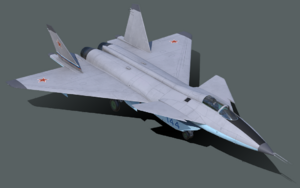Tlo-45
| Tlo-45 Condor | |
|---|---|

| |
| Role | Fighter |
| Manufacturer | Cuauhquetztia |
| Designer | NTT 144 |
| First flight | 1998 |
| Introduction | 2000 |
| Status | In service |
| Primary user | Zacapine Armed Forces |
| Number built | 450 |
| Unit cost |
40-50 million
|
The Tlo-45 Condor is a twin-engine multirole fighter aircraft developed by NTT 144 and manufactured by Cuauhquetztia for the Zacapine Armed Forces and export clients. The Tlo-45 incorporates many design elements characteristic of the 5th generation of fighter aircraft including supermaneuverability, supercruise, next generation avionics and limited stealth capabilities in the form of radar signature reduction and electronic countermeasures, but is classified as an advanced 4.5 or 4++ generation aircraft. It was designed in response to the emerging initiatives towards next generation combat aircraft such as the Morgenroete F-104 Ghost which saw its first flight in 1996 while keeping within both the technological capabilities of the Zacapine military industrial sector and more importantly the financial realities of the military budgets of Zacapican and other potential clients in Malaio. The Tlo-45 is one of three Zacapine aircraft to emerge from the New Millennium Combat Aircraft initiative, the others being the singe-engine light fighter Tlo-47 and the unorthodox Tlo-54 notable for its forward-swept wing design.
Development
(Attempted use of Plasma stealth)
Design
The Tlo-45 is a delta wing twin-tailed, twin-engine air superiority and strike fighter incorporating a suite of sophisticated technology to improve its flight, combat and stealth characteristics. Its excellent maneuverability stems from thrust vectoring nozzles integrated into its engine systems as well as the close-coupled canards which give the aircraft its distinctive silhouette, allowing the fighter to fully satisfy the supermaneuverability aspect of its design requirements. The aircraft features a fly-by-wire flight control system required to overcome the inherent negative stability emerging as a consequence of design elements intended to increase the stealth and maneuverability of the fighter. Maneuverability was also improved by weight saving measures in the designs, including the use of titanium and Aluminium–lithium alloys as well as composites with only minimum use of various steel alloys.
Significant efforts were made in the development stage to improve efficiency and implement stealth characteristics to make the Tlo-45 competitive on the modern battlefield. Unconventional measures were implimented, such as the reduction of surface area to reduce drag and radar signature. Electronic warfare systems including the electronic countermeasures complimented the stealth systems of the aircraft were housed in wingtip fairings with dielectric insulation. The forward canards, swept at a slightly higher angle than the delta wings, featured a notable dogtooth improving airflow over the main wings at high angles of attack. Stealth is additionally served by the use of radar-absorbent material and the large internal weapons bay which would allow a payload of up to 12 missiles to be carried internally, reducing radar signature. For strike missions or in combat zones with low threat of radar detection, additional heavy armaments coulkd be mounted to external hardpoints on the wings to improve the payload capacity. Without externally mounted weapons, the Tlo-17 boasts a minimal radar cross-section of roughly 0.4 m2 (4.3 sq ft)